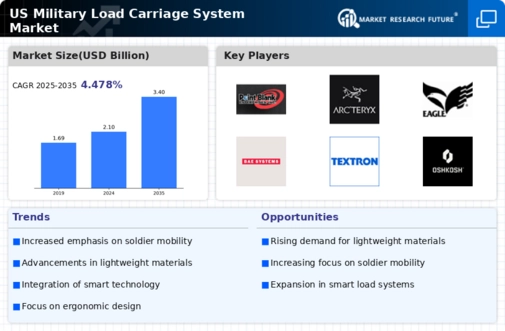Focus on Soldier Safety
The market is increasingly driven by a focus on soldier safety and well-being. With the recognition that heavy loads can lead to injuries and fatigue, military organizations are prioritizing the development of ergonomic and lightweight load-carrying systems. Recent studies indicate that improper load distribution can result in injuries for up to 30% of soldiers during operations. This awareness has prompted investments in research and development aimed at creating systems that minimize physical strain. As a result, manufacturers are likely to see a growing demand for innovative designs that enhance comfort and reduce the risk of injury. The military load-carriage-system market is thus evolving to meet these critical safety standards.
Technological Integration
The military load-carriage-system market is witnessing a trend towards technological integration, which enhances functionality and efficiency. Innovations such as smart textiles, integrated communication devices, and GPS tracking are becoming increasingly prevalent. These technologies not only improve the operational capabilities of soldiers but also facilitate better logistics and supply chain management. The integration of technology into load-carrying systems is expected to grow, with projections indicating a market increase of 15% in the next five years. This trend suggests that manufacturers who invest in advanced technologies will likely gain a competitive edge in the military load-carriage-system market.
Rising Operational Demands
The military load-carriage-system market is influenced by rising operational demands placed on military personnel. As military engagements become more diverse and challenging, soldiers require efficient load-carrying solutions that can accommodate various mission profiles. The need for systems that support rapid deployment and adaptability is paramount. Reports suggest that the average load carried by soldiers has increased by 20% over the past decade, necessitating advancements in load-carriage technology. This trend compels manufacturers to innovate and produce systems that not only enhance mobility but also ensure the safety and comfort of personnel. The military load-carriage-system market is thus likely to see a surge in demand for products that can effectively address these operational challenges.
Increased Military Spending
The military load-carriage-system market is experiencing growth due to increased military spending in the United States. The U.S. government has allocated substantial budgets for defense, with a projected increase of approximately 5% annually over the next five years. This financial commitment is likely to enhance the procurement of advanced load-carriage systems, which are essential for operational efficiency. As military operations become more complex, the demand for innovative and durable load-carrying solutions is expected to rise. This trend indicates a robust market environment, where manufacturers are encouraged to develop cutting-edge technologies that meet the evolving needs of armed forces. Consequently, the military load-carriage-system market is poised for expansion, driven by the necessity for enhanced performance and reliability in military operations.
Increased Emphasis on Customization
The military load-carriage-system market is experiencing a shift towards increased emphasis on customization to meet the specific needs of various military units. Different branches of the military have unique operational requirements, necessitating tailored load-carrying solutions. This trend is reflected in the growing demand for modular systems that can be adapted for different missions. Reports indicate that customized solutions can enhance operational efficiency by up to 25%. As military organizations seek to optimize their resources, manufacturers are likely to respond by offering more versatile and adaptable products. This focus on customization is expected to drive growth in the military load-carriage-system market, as it aligns with the strategic goals of enhancing mission effectiveness.




















Leave a Comment